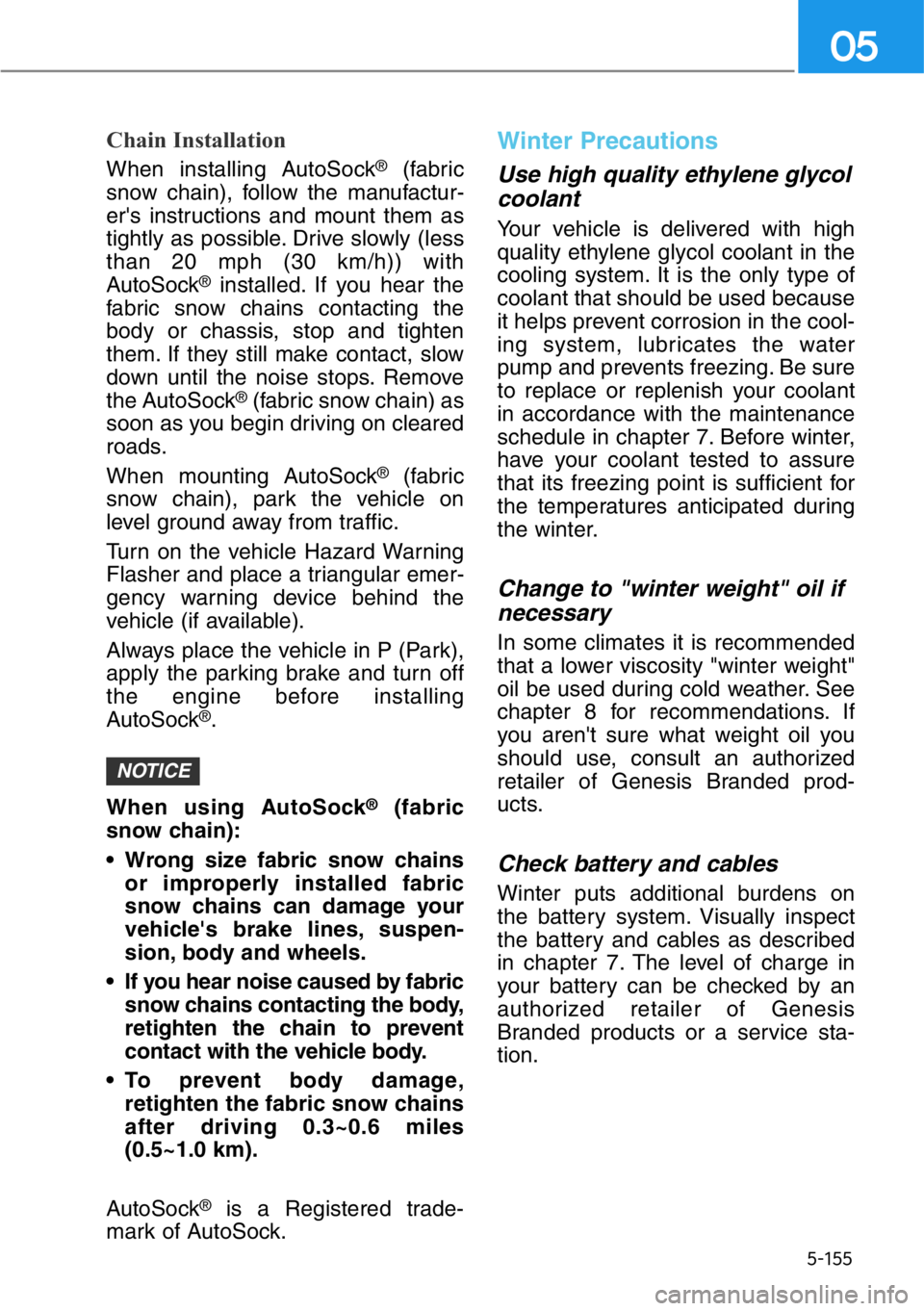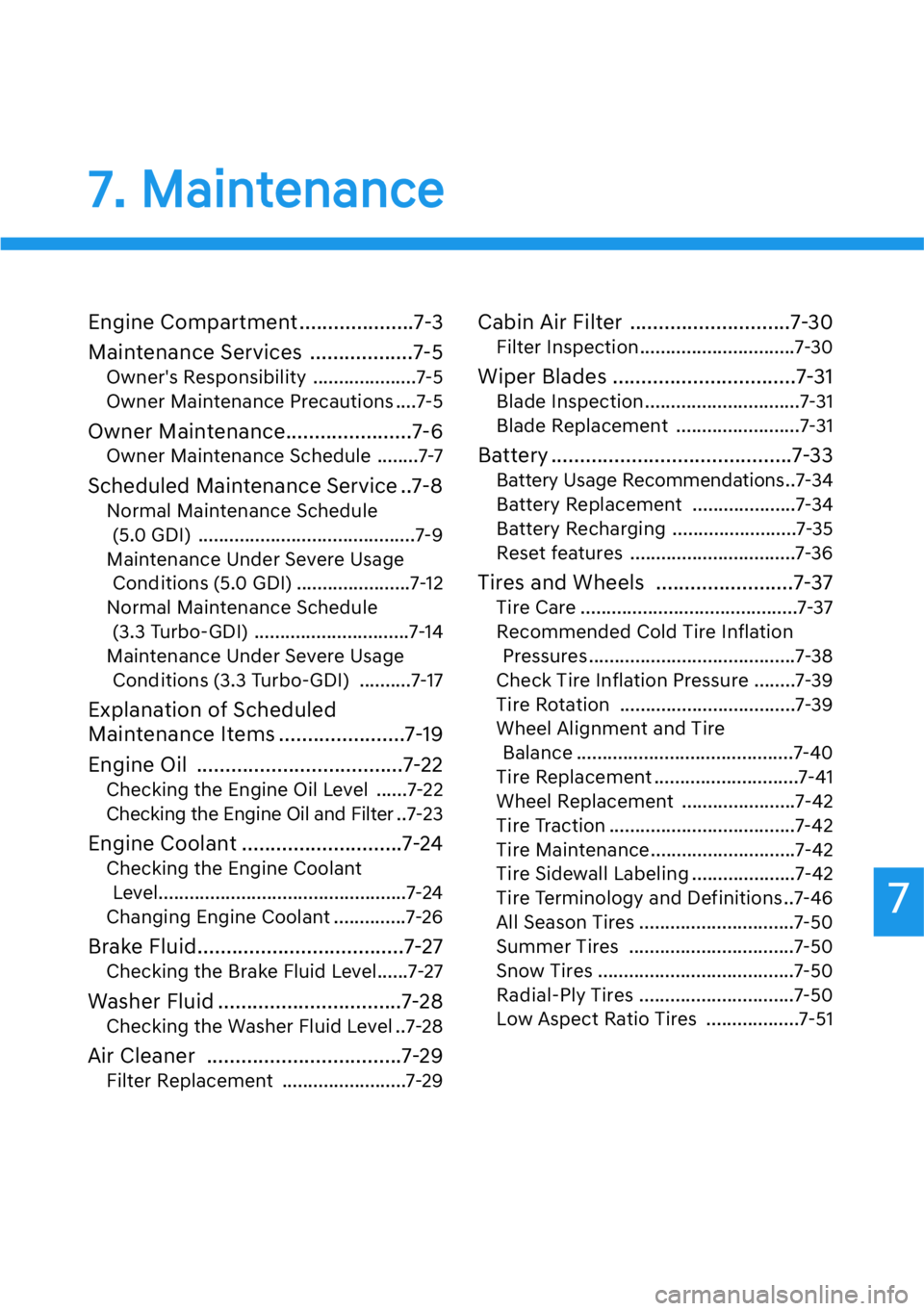coolant level GENESIS G90 2021 Owner's Manual
[x] Cancel search | Manufacturer: GENESIS, Model Year: 2021, Model line: G90, Model: GENESIS G90 2021Pages: 538, PDF Size: 13.02 MB
Page 404 of 538

5-152
Driving your vehicle
Driving in Flooded Areas
Avoid driving through flooded areas
unless you are sure the water is no
higher than the bottom of the wheel
hub. Drive through any water slowly.
Allow adequate stopping distance
because brake performance may be
reduced.
After driving through water, dry the
brakes by gently applying them sev-
eral times while the vehicle is moving
slowly.
Highway Driving
Tires
Adjust the tire inflation, as specified.
Under-inflation may overheat or
damage the tires.
Do not install worn-out or damaged
tires, which may reduce traction or
fail the braking operation.
Information
Never over-inflate your tires above the
maximum inflation pressure, as speci-
fied on your tires.
Fuel, engine coolant and engine
oil
Driving at higher speeds on the high-
way consumes more fuel and is less
efficient than driving at a slower,
more moderate speed. Maintain a
moderate speed in order to conserve
fuel when driving on the highway.
Be sure to check both the engine
coolant level and the engine oil
before driving.
Drive belt
A loose or damaged drive belt may
overheat the engine.
i
Utility vehicles have a signifi-
cantly higher rollover rate than
other types of vehicles. To pre-
vent rollovers or loss of control:
• Take corners at slower speeds
than you would with a passen-
ger vehicle.
• Avoid sharp turns and abrupt
maneuvers.
• Do not modify your vehicle in
any way that you would raise
the center of gravity.
• Keep tires properly inflated.
• Do not carry heavy cargo on
the roof.
WARNING
In a rollover crash, an unbelted
person is significantly more
likely to die than a person wear-
ing a seat belt. Make sure all
passengers are wearing their
seat belts.
WARNING
Page 407 of 538

5-155
05
Chain Installation
When installing AutoSock®(fabric
snow chain), follow the manufactur-
er's instructions and mount them as
tightly as possible. Drive slowly (less
than 20 mph (30 km/h)) with
AutoSock
®installed. If you hear the
fabric snow chains contacting the
body or chassis, stop and tighten
them. If they still make contact, slow
down until the noise stops. Remove
the AutoSock
®(fabric snow chain) as
soon as you begin driving on cleared
roads.
When mounting AutoSock
®(fabric
snow chain), park the vehicle on
level ground away from traffic.
Turn on the vehicle Hazard Warning
Flasher and place a triangular emer-
gency warning device behind the
vehicle (if available).
Always place the vehicle in P (Park),
apply the parking brake and turn off
the engine before installing
AutoSock
®.
When using AutoSock
®(fabric
snow chain):
• Wrong size fabric snow chains
or improperly installed fabric
snow chains can damage your
vehicle's brake lines, suspen-
sion, body and wheels.
• If you hear noise caused by fabric
snow chains contacting the body,
retighten the chain to prevent
contact with the vehicle body.
• To prevent body damage,
retighten the fabric snow chains
after driving 0.3~0.6 miles
(0.5~1.0 km).
AutoSock
®is a Registered trade-
mark of AutoSock.
Winter Precautions
Use high quality ethylene glycol
coolant
Your vehicle is delivered with high
quality ethylene glycol coolant in the
cooling system. It is the only type of
coolant that should be used because
it helps prevent corrosion in the cool-
ing system, lubricates the water
pump and prevents freezing. Be sure
to replace or replenish your coolant
in accordance with the maintenance
schedule in chapter 7. Before winter,
have your coolant tested to assure
that its freezing point is sufficient for
the temperatures anticipated during
the winter.
Change to "winter weight" oil if
necessary
In some climates it is recommended
that a lower viscosity "winter weight"
oil be used during cold weather. See
chapter 8 for recommendations. If
you aren't sure what weight oil you
should use, consult an authorized
retailer of Genesis Branded prod-
ucts.
Check battery and cables
Winter puts additional burdens on
the battery system. Visually inspect
the battery and cables as described
in chapter 7. The level of charge in
your battery can be checked by an
authorized retailer of Genesis
Branded products or a service sta-
tion.
NOTICE
Page 422 of 538

6-8
What to do in an emergency
6. If you cannot find the cause of the
overheating, wait until the engine
temperature has returned to nor-
mal. Then, if coolant has been
lost, carefully add coolant to the
reservoir to bring the fluid level in
the reservoir up to the halfway
mark.
7. Proceed with caution, keeping
alert for further signs of overheat-
ing. If overheating happens again,
call an authorized retailer of
Genesis Branded products for
assistance.
Serious loss of coolant indicates a
leak in the cooling system and
should be checked as soon as
possible by an authorized retailer
of Genesis Branded products.
NOTICE
Your vehicle is
equipped with a pres-
surized coolant
reserve tank. NEVER
remove the radiator
cap, drain plug and heater hose
connector cap (refer to the
below picture) while the engine
and radiator are hot. Hot
coolant and steam may blow
out under pressure, causing
serious injury.
Turn the engine off and wait
until the engine cools down.
Use extreme care when remov-
ing the coolant reserve tank
cap. Wrap a towel or thick rag
around it, and turn it counter-
clockwise slowly to release
some of the pressure from the
system. Step back while the
pressure is released.
When you are sure all the pres-
sure has been released, contin-
ue turning the cap counter-
clockwise to remove it.
■Heater hose connector cap
(for 5.0 GDI engine)
WARNING
OHI078060L
Page 441 of 538

7
7. Maintenance
Engine Compartment ....................7-3
Maintenance Services ..................7-5
Owner's Responsibility ....................7-5
Owner Maintenance Precautions ....7-5
Owner Maintenance......................7-6
Owner Maintenance Schedule ........7-7
Scheduled Maintenance Service ..7-8
Normal Maintenance Schedule
(5.0 GDI) ..........................................7-9
Maintenance Under Severe Usage
Conditions (5.0 GDI) ......................7-12
Normal Maintenance Schedule
(3.3 Turbo-GDI) ..............................7-14
Maintenance Under Severe Usage
Conditions (3.3 Turbo-GDI) ..........7-17
Explanation of Scheduled
Maintenance Items ......................7-19
Engine Oil ....................................7-22
Checking the Engine Oil Level ......7-22
Checking the Engine Oil and Filter ..7-23
Engine Coolant ............................7-24
Checking the Engine Coolant
Level................................................7-24
Changing Engine Coolant ..............7-26
Brake Fluid....................................7-27
Checking the Brake Fluid Level......7-27
Washer Fluid ................................7-28
Checking the Washer Fluid Level ..7-28
Air Cleaner ..................................7-29
Filter Replacement ........................7-29
Cabin Air Filter ............................7-30
Filter Inspection..............................7-30
Wiper Blades ................................7-31
Blade Inspection ..............................7-31
Blade Replacement ........................7-31
Battery ..........................................7-33
Battery Usage Recommendations..7-34
Battery Replacement ....................7-34
Battery Recharging ........................7-35
Reset features ................................7-36
Tires and Wheels ........................7-37
Tire Care ..........................................7-37
Recommended Cold Tire Inflation
Pressures ........................................7-38
Check Tire Inflation Pressure ........7-39
Tire Rotation ..................................7-39
Wheel Alignment and Tire
Balance ..........................................7-40
Tire Replacement ............................7-41
Wheel Replacement ......................7-42
Tire Traction ....................................7-42
Tire Maintenance............................7-42
Tire Sidewall Labeling ....................7-42
Tire Terminology and Definitions ..7-46
All Season Tires ..............................7-50
Summer Tires ................................7-50
Snow Tires ......................................7-50
Radial-Ply Tires ..............................7-50
Low Aspect Ratio Tires ..................7-51
Page 447 of 538

7-7
07
Owner Maintenance Schedule
When you stop for fuel:
• Check the engine oil level.
• Check the coolant level in the
engine coolant reservoir.
• Check the windshield washer fluid
level.
• Check the tire for low or under-
inflated tires.
While operating your vehicle:
• Note any changes in the sound of
the exhaust or any smell of exhaust
fumes in the vehicle.
• Check for vibrations in the steering
wheel. Notice if there is any
increased steering effort or loose-
ness in the steering wheel, or
change in its straight-ahead posi-
tion.
• Notice if your vehicle constantly
turns slightly or "pulls" to one side
when traveling on smooth, level
road.
• When stopping, listen and check
for unusual sounds, pulling to one
side, increased brake pedal travel
or "hard-to-push" brake pedal.
• If any slipping or changes in the
operation of your transmission
occurs, check the transmission
fluid level.
• Check the automatic transmission
P (Park) function.
• Check the parking brake.
• Check for fluid leaks under your
vehicle (water dripping from the air
conditioning system during or after
use is normal).
At least monthly:
• Check coolant level in the engine
coolant reservoir.
• Check the operation of all exterior
lights, including the brake lights,
turn signals and hazard warning
flashers.
• Check the inflation pressures of all
tires including the spare for tires
that are worn, show uneven wear,
or are damaged.
• Check for loose wheel lug nuts. Be careful when checking your
engine coolant level when the
engine is hot. This may result in
coolant being blown out of the
opening and cause serious
burns and other injuries.
WARNING
Page 464 of 538

7-24
Maintenance
The high-pressure cooling system
has a reservoir filled with year-round
antifreeze coolant. The reservoir is
filled at the factory.
Check the antifreeze protection and
coolant level at least once a year, at
the beginning of the winter season
and before traveling to a colder cli-
mate.
Checking the Engine Coolant
Level
Check the condition and connections
of all cooling system hoses and
heater hoses. Replace any swollen
or deteriorated hoses.
The coolant level should be filled
between the F and the L marks on
the side of the coolant reservoir
when the engine is cool.
If the coolant level is low, add enough
distilled (deionized) water to bring
the level to the F mark, but do not
overfill. If frequent additions are
required, we recommend that you
see an authorized retailer of Genesis
Branded products for a cooling sys-
tem inspection.
ENGINE COOLANT
OHI078010
■3.3 T-GDI
OHI078012
■5.0 GDI
Page 468 of 538

7-28
Maintenance
WASHER FLUID
Checking the Washer Fluid
Level
Check the fluid level in the washer
fluid reservoir and add fluid if neces-
sary. Plain water may be used if
washer fluid is not available.
However, use washer solvent with
antifreeze characteristics in cold cli-
mates to prevent freezing.To prevent serious injury or
death, take the following safety
precautions when using washer
fluid:
• Do not use engine coolant or
antifreeze in the washer fluid
reservoir. Engine coolant can
severely obscure visibility
when sprayed on the wind-
shield and may cause loss of
vehicle control resulting in an
accident or damage to paint
and body trim.
• Do not allow sparks or flame
to contact the washer fluid or
the washer fluid reservoir.
Washer fluid may contain
alcohol and can be flamma-
ble.
• Do not drink washer fluid and
avoid contact with skin.
Washer fluid is harmful to
humans and animals.
• Keep washer fluid away from
children and animals.
WARNING
OHI078017